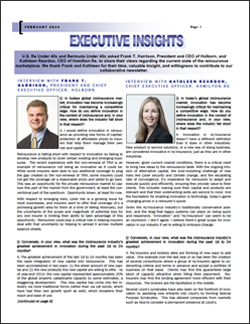INTERVIEW WITH FRANK T. HARRISON, PRESIDENT AND CHIEF EXECUTIVE OFFICER, HOLBORN
Q: In todays global (re)insurance market, innovation has become increasingly critical for maintaining a competitive edge. How do you define innovation in the context of (re)insurance and, in your view, where does the industry fall short in that respect?
A: I would define innovation in reinsurance as providing new forms of capital/ protection at affordable prices to insurers that help them manage their own risk and capital.
Reinsurance is falling short with respect to innovation by failing to develop new products to cover certain existing and emerging exposures. The recent experience with the non-renewal of TRIA is an example of reinsurance not being as innovative as it could be. While some insurers were able to buy additional coverage to plug the gap created by the non-renewal of TRIA, some insurers could not get the coverage (at a reasonable price) and opted to go bare. This was an opportunity for the private reinsurance market to capture this part of the market from the government, at least the conventional part of the spectrum. Opportunity blown, at least for now.
With respect to emerging risks, cyber risk is a growing issue for most businesses, and insurers want to offer that coverage (it’s a promising growth area for them at a time of falling revenues), but the uncertainty of the scope and magnitude of potential loss for any one insurer is limiting their ability to take advantage of this opportunity. Reinsurers could play a critical role in helping insurers deal with that uncertainty by helping to spread it across multiple balance sheets.
Q: Conversely, in your view, what was the (re)insurance industry’s greatest achievement in innovation during the past 18 to 24 months?
A: The greatest achievement of the last 18 to 24 months has been the rapid integration of new capital into reinsurance. This has been accomplished in two ways: (1) the sheer amount of new capital and (2) the new products this new capital are willing to offer. As of year-end 2014, the new capital represented approximately 20% of the global property catastrophe capacity by some estimates, a staggering development. This new capital has come into the industry via more traditional forms (rather than via cat bonds, which have had their own growth spurt as well), which broadens their reach and ease of use.
This dramatic increase in capacity, along with an on-going benign catastrophe environment, has driven down rates and contributed to a deepening soft market.
This new capacity is not only putting pressure on rates, it is offering new products and structures. For example, reinsurers are offering cascading coverage, hybrid occurrence-aggregate covers and are broadening coverage terms such as hours clauses and reinstatement provisions. Multiple year policies are now a part of the mainstream.
All of this benefits reinsurers’ clients – they get better coverage for less. Many of our clients are using the savings and the flexibility to expand limit and fill in perceived gaps in coverage.
Q: The demand for innovation is not limited to a (re)insurer’s product and service offerings. Instead, innovation must be fostered throughout an enterprise, potentially affecting risk management, marketing, capital management, and financial reporting, to name a few. Based on your experience, where will the (re)insurance industry see the greatest achievements in innovation over the next 18 to 24 months?
A: With the influx of new capital, traditional reinsurers will have to change their fundamental business strategies with respect to return expectations. As respects returns, as mentioned above, the new capital has been partially responsible for driving down property catastrophe reinsurance rates (and rates in other areas as part of a knock-on effect). The other driver of the soft market is the benign catastrophe loss experience. As such, many of the new capital providers have not had to deal with losses – paying claims, dealing with the basis risk of modeled versus actual loss, investor expectations, etc.
I believe the new capital needs to be tested and needs to settle in before we see substantial further innovation. Reinsurance brokers, on the other hand, continue to assist clients in a multitude of ways to achieve clients’ targets. At Holborn, we work carefully with each client and build tools as necessary to produce a highly customized service offering to match the goals and objectives of the client. Enterprise risk management, regulatory (including Own Risk Solvency Assessment – “ORSA”), capital management, rating and modeling tools and so on, continue to become more sophisticated and highly customized in their use, client-by-client. The development and use of these tools is where we will see the greatest innovation in the next 18-24 months.


